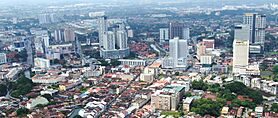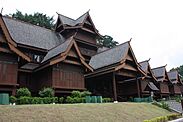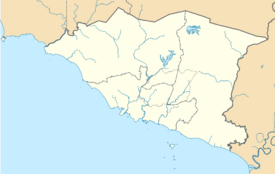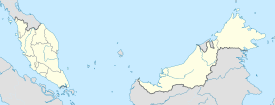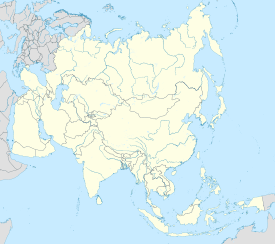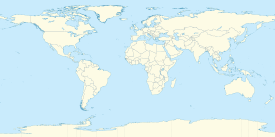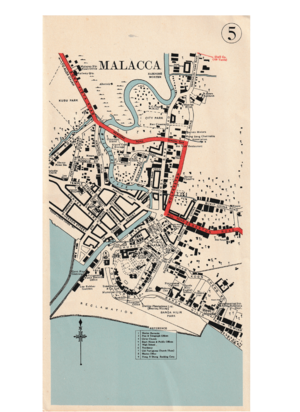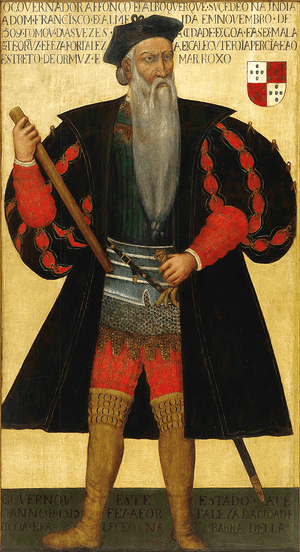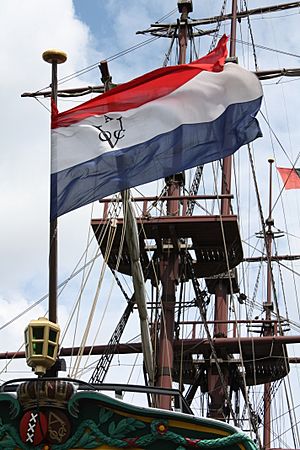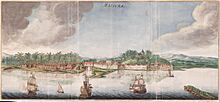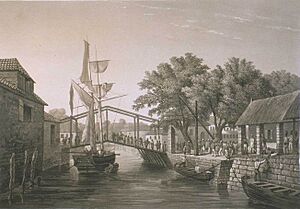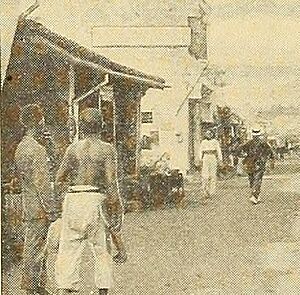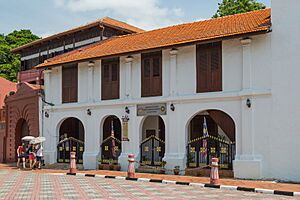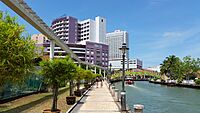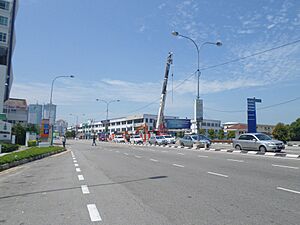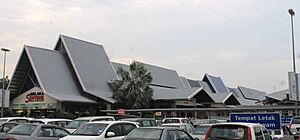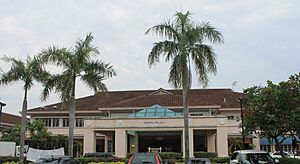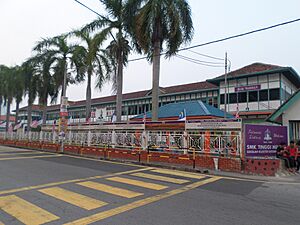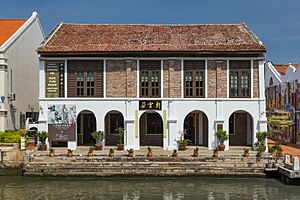Malacca City facts for kids
Quick facts for kids
Malacca
|
|||
|---|---|---|---|
|
City and state capital
|
|||
| City of Malacca Bandaraya Melaka |
|||
| Other transcription(s) | |||
| • Jawi | باندراي ملاک | ||
| • Chinese | 马六甲市 (Simplified) 馬六甲市 (Traditional) Mǎliùjiǎ shì (Hanyu Pinyin) |
||
| • Tamil | மலாக்கா மாநகரம் Malākkā mānakaram (Transliteration) |
||
|
From top, left to right:
Panorama view of Malacca, Taming Sari Tower, the Melaka Sultanate Palace Museum, Porta de Santiago, St. Francis Xavier statue in front of St. Paul's Church, the Christ Church beside the Stadthuys, the Melaka Straits Mosque, and the Malacca City Council Building. |
|||
|
|||
| Nickname(s):
Bandaraya Bersejarah
Historical City |
|||
| Country | |||
| State | |||
| District | Melaka Tengah | ||
| Founded | 1396 | ||
| Establishment of the local government | 1824 | ||
| Municipality status | 1 January 1977 | ||
| City status | 15 April 2003 | ||
| Government | |||
| • Type | City council | ||
| • Body | Malacca City Council | ||
| Area | |||
| • City and state capital | 277 km2 (107 sq mi) | ||
| • Metro | 307.86 km2 (118.87 sq mi) | ||
| Elevation | 6 m (20 ft) | ||
| Population
(2019)
|
|||
| • City and state capital | 579,000 | ||
| • Demonym | Malaccans | ||
| Time zone | UTC+8 (MST) | ||
| • Summer (DST) | Not observed | ||
| Postal code |
75xxx to 78xxx
|
||
| Area code(s) | 06 | ||
| Vehicle registration | M | ||
| UNESCO World Heritage Site | |||
| Official name | The Historic City of Melaka | ||
| Part of | Melaka and George Town, the Historic Cities of the Straits of Malacca | ||
| Criteria | Cultural: (ii)(iii)(iv) | ||
| Inscription | 2008 (32nd Session) | ||
| Extensions | 2011 | ||
| Area | 45.3 ha (112 acres) | ||
| Buffer zone | 242.8 ha (600 acres) | ||
Malacca City (also called Bandaraya Melaka or Kota Melaka) is the capital city of the Malaysian state of Malacca. It is the oldest Malaysian city located along the Straits of Malacca. Malacca became a very important trading port during the time of the Malacca Sultanate.
The city was started by Parameswara, a prince from Sumatra. He came to the Malay Peninsula after his kingdom, Srivijaya, was attacked. After the Malacca Sultanate was formed, traders from many parts of the world came here. These included people from the Middle East, South Asia, East Asia, and even the Portuguese. Everyone wanted to control the busy trade routes in Asia.
After Portugal took over Malacca, the city became a battleground. The sultanates of Aceh and Johor both tried to gain control. Later, Johor worked with the Dutch to take Malacca from the Portuguese. This happened because the Dutch wanted to control trade in other islands like Java.
Eventually, the British arrived and Malacca became part of their empire. The city grew and became very successful. However, this growth stopped during World War II when the Japanese occupied the area from 1942 to 1945. Many people from Malacca were forced to work on the Burma Railway, also known as the "Death Railway," in Myanmar.
After the war, the British returned Malacca. It remained the capital of the state until Malaysia was formed in 1963. In 2008, Malacca City was recognized as a World Heritage Site by UNESCO. This was because of its long and rich history. As of 2019, about 579,000 people live in Malacca City.
Malacca City's economy mostly depends on tourism. It is also a major business hub for the state of Malacca. The city hosts many international meetings and trade shows. Malacca is located along the Maritime Silk Road, a trade route proposed by China. Some popular places to visit include Porta de Santiago, Jonker Walk, Little India, and the Taming Sari Tower.
Contents
What's in a Name? The Story of Malacca's Name
According to an old story, Malacca City got its name from a tree. Parameswara, the Sumatran prince who founded the city, was resting under a Malacca tree. He saw a tiny mouse deer bravely kick his hunting dogs into a river. Parameswara was so amused by this that he decided to name the place Malaka after the tree.
There are other ideas about where the name came from. One idea is that the name Malaqa means "fugitive." This might refer to Parameswara's past as someone who had to escape. Another idea is that Arab traders called the kingdom Malakat. This Arabic word means "congregation of merchants," because many traders gathered there.
When the Portuguese took over, they spelled the name "Malaca." The Dutch called it "Malakka" or "Malacka." Under British rule, it became "Malacca." The famous Straits of Malacca were named after this important city.
A Look Back: Malacca's History
![]() Sultanate of Malacca 1396–1511
Sultanate of Malacca 1396–1511
![]() Portuguese Empire 1511–1641
Portuguese Empire 1511–1641
![]() Dutch Empire 1641–1795; 1818–1825
Dutch Empire 1641–1795; 1818–1825
![]() Straits Settlements 1826–1942; 1945–1946
Straits Settlements 1826–1942; 1945–1946
![]() Empire of Japan 1942–1945
Empire of Japan 1942–1945
![]() Malayan Union 1946–1948
Malayan Union 1946–1948
![]() Federation of Malaya 1948–1963
Federation of Malaya 1948–1963
![]() Malaysia 1963–present
Malaysia 1963–present
How Malacca Was Founded
Malacca was founded by Parameswara. He had to leave Palembang in Sumatra after his kingdom was attacked. He first tried to build a new kingdom in Temasek (now Singapore). But he had to leave there too, fearing trouble from the Siamese King.
Parameswara then traveled north on the Malay Peninsula. He stopped at a fishing village near the Malacca River. It was here that he saw the mouse deer kick his dogs. Amused, he decided this was a special place. In 1396, he named it Malaka.
Soon, Malacca became a very important trading center. It was a busy port for goods from all over Asia. In 1403, the first Chinese trade group arrived. They were led by Admiral Yin Qing. Later, Admiral Zheng He also visited Malacca.
Malacca became friends with the Ming Empire of China. This friendship protected Malacca from attacks by Siam and Majapahit. It helped Malacca grow into a major trading hub. Goods moved between China, India, the Middle East, Africa, and Europe through Malacca.
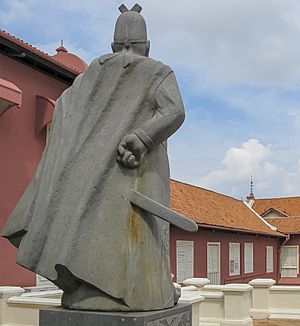
A Chinese traveler named Ma Huan described Malacca as a strong city. It had walls, watchtowers, and a special area for merchants and treasures. The Malacca River split the city in two. One side had the ruler's area, and the other had homes for foreign merchants. The bridge over the river was a busy market.
The Ming Chinese wanted Malacca to be a big trading center. In 1405, the Ming court officially recognized Malacca as an important country. They even set up a special area for their soldiers. Because of China's support, Siam no longer dared to attack Malacca.
To make their friendship stronger, a Chinese princess named Hang Li Po came to Malacca. She married Sultan Manshur Shah. Her 500 helpers also settled in Malacca, mostly in Bukit Cina. This Chinese involvement helped Malacca become a key port.
Malacca soon became an Islamic sultanate. Parameswara converted to Islam and changed his name to Sultan Iskandar Shah. He married a princess from Pasai. With Chinese protection, Malacca became a powerful empire. It could not be conquered by Majapahit or Siam. During this time, Hindu-Malay and Tamil-Malay communities also formed.
Malacca continued to thrive under Sultan Mahmud Shah. Different traders specialized in different goods. Gujaratis, Tamils, and Bengalis sold cloth. Arabs and Persians traded goods from China. The Chinese dealt in silk and porcelain. People from the Malay Archipelago traded spices. The Javanese controlled rice and food. The Chinese had their own area in the city, around a hill called Bukit Cina. They built temples and a well there, named after Princess Hang Li Po.
European Powers Arrive
Malacca's wealth attracted the Portuguese. They had already set up trading posts in India. In 1509, King Manuel I sent Diogo Lopes de Sequeira to Malacca. Sultan Mahmud Shah first welcomed him. However, Tamil Muslim traders warned the Sultan about how the Portuguese treated Muslims in Goa. The Sultan then ordered some Portuguese to be captured and killed. Some managed to escape.
In April 1511, Afonso de Albuquerque arrived with his fleet. He wanted to stop the trade between Malacca and other Muslim and European cities. He believed that taking Malacca would greatly harm trade in Cairo and Mecca.
The Portuguese attacked on July 25, 1511, but failed. Albuquerque launched another attack on August 15, 1511, and succeeded. Malacca was captured that day. The Portuguese built a fortress called A Famosa. They used stones from Muslim graves and mosques for its construction. They also built churches and government buildings. The Portuguese made Chinese traders pay higher taxes and limited their land ownership. China was unhappy about this and about Portuguese actions in other areas.
By the mid-1500s, the sultanates of Aceh and Johor wanted to take Malacca from the Portuguese. This led to many conflicts. Aceh attacked Johor's capital and made Johor a vassal state. Both the Portuguese and Johor saw Aceh as a threat. They sometimes worked together to fight Aceh.
After Aceh became weaker, the Dutch East India Company (VOC) arrived. Johor made a deal with the Dutch to remove the Portuguese. In 1641, the Dutch successfully captured Malacca. The Dutch expanded the city's fort and built more buildings. They were more interested in Java and the Maluku Islands. So, they stayed out of local fights until the Bugis people started threatening their trade.
From 1796 to 1801, and again from 1807 to 1818, Malacca was controlled by the British. This happened because the Netherlands were taken over by France during the Napoleonic Wars. Malacca was given back to the Dutch in 1818. A treaty was signed in 1824 between the British and Dutch. This treaty divided the Johor-Riau Empire between them. Malacca was officially given to the British in 1825. It became part of the Straits Settlements. The British dismantled the old fort. They also set up new rules for building things like back alleys and fire escapes.
World War II and Modern Malacca
During World War II, the Japanese Army arrived in Malacca on January 14, 1942. They mostly focused on pushing the British south. So, there were no big battles in Malacca City. During the Japanese occupation, a special police headquarters was set up. Many people were forced to work on the Burma–Siam Railway in Thailand.
When the war ended in August 1945, the Japanese surrendered. Malacca City was not heavily damaged. It was then managed by the British until the formation of the Malayan Union and later the Federation of Malaya. After Malaya became independent in 1957, a building called "Malacca Club" was turned into a memorial. It celebrates Malaya's independence day.
In 1963, the Federation of Malaysia was formed. Malacca Town grew a lot, but many of its old buildings from colonial times were kept. In 1989, Malacca Town was given the title "Historical City." In 2003, it officially became a city. On July 7, 2008, Malacca City was listed as a UNESCO World Heritage Site. It shares this honor with George Town in Penang.
Where is Malacca City?
Malacca City is located on both sides of the Malacca River. It is near where the river meets the Straits of Malacca. The city is about 152 kilometers from Malaysia's capital, Kuala Lumpur. The city has grown bigger, especially in the south, because of land being reclaimed from the sea. The land is mostly flat or gently rolling.
The old part of the city is near the coast. It includes St Paul's Hill with the ruins of the Portuguese fortress. The Dutch Square is on the east side of the river. The old Chinatown is on the west side. Bukit Cina, a hill with a large old Chinese cemetery, is now surrounded by new buildings.
Malacca's Weather
Malacca has hot and humid weather all year round. It gets rainfall, but the amount changes depending on the time of year. It is one of the drier cities in Malaysia. It receives less rain than most other parts of Peninsular Malaysia. However, Malacca does not have a dry season. It gets more than 100 millimeters of rain every month. Malacca has a tropical rainforest climate. This means it's always warm and rainy, with no cyclones. The stable weather makes Malacca a great place to visit any time of the year.
| Climate data for Malacca (1991–2020 normals, extremes 1930–2020) | |||||||||||||
|---|---|---|---|---|---|---|---|---|---|---|---|---|---|
| Month | Jan | Feb | Mar | Apr | May | Jun | Jul | Aug | Sep | Oct | Nov | Dec | Year |
| Record high °C (°F) | 35.2 (95.4) |
37.8 (100.0) |
37.2 (99.0) |
37.3 (99.1) |
38.0 (100.4) |
34.7 (94.5) |
35.7 (96.3) |
35.0 (95.0) |
35.6 (96.1) |
35.6 (96.1) |
34.4 (93.9) |
34.6 (94.3) |
38.0 (100.4) |
| Mean daily maximum °C (°F) | 31.8 (89.2) |
32.9 (91.2) |
33.2 (91.8) |
33.0 (91.4) |
32.6 (90.7) |
32.1 (89.8) |
31.6 (88.9) |
31.6 (88.9) |
31.8 (89.2) |
32.1 (89.8) |
31.7 (89.1) |
31.3 (88.3) |
32.1 (89.8) |
| Daily mean °C (°F) | 26.9 (80.4) |
27.5 (81.5) |
27.8 (82.0) |
28.0 (82.4) |
28.2 (82.8) |
27.9 (82.2) |
27.5 (81.5) |
27.4 (81.3) |
27.4 (81.3) |
27.4 (81.3) |
26.9 (80.4) |
26.7 (80.1) |
27.5 (81.5) |
| Mean daily minimum °C (°F) | 23.7 (74.7) |
23.9 (75.0) |
24.3 (75.7) |
24.5 (76.1) |
24.6 (76.3) |
24.4 (75.9) |
23.9 (75.0) |
23.9 (75.0) |
23.9 (75.0) |
24.0 (75.2) |
23.9 (75.0) |
23.8 (74.8) |
24.1 (75.4) |
| Record low °C (°F) | 19.0 (66.2) |
20.0 (68.0) |
20.0 (68.0) |
19.0 (66.2) |
20.0 (68.0) |
20.0 (68.0) |
19.0 (66.2) |
20.0 (68.0) |
21.0 (69.8) |
21.0 (69.8) |
21.0 (69.8) |
20.0 (68.0) |
19.0 (66.2) |
| Average precipitation mm (inches) | 102.1 (4.02) |
79.7 (3.14) |
129.1 (5.08) |
166.1 (6.54) |
167.3 (6.59) |
172.6 (6.80) |
196.0 (7.72) |
219.5 (8.64) |
161.7 (6.37) |
189.4 (7.46) |
233.1 (9.18) |
177.1 (6.97) |
1,993.8 (78.50) |
| Average precipitation days (≥ 1.0 mm) | 8.0 | 6.5 | 10.1 | 11.9 | 10.6 | 9.4 | 11.7 | 12.4 | 11.4 | 12.1 | 15.7 | 12.5 | 132.3 |
| Average relative humidity (%) | 80 | 79 | 82 | 85 | 86 | 86 | 86 | 86 | 86 | 86 | 87 | 83 | 84 |
| Mean monthly sunshine hours | 166 | 185 | 183 | 179 | 171 | 164 | 163 | 166 | 174 | 171 | 157 | 152 | 2,031 |
| Source 1: World Meteorological Organization | |||||||||||||
| Source 2: Ogimet Deutscher Wetterdienst (extremes and humidity) | |||||||||||||
Who Lives in Malacca City?
People and Religions
In 2010, Malacca City had a population of 484,885 people. Most of the people were Malays. There were also many Chinese and Indian residents. About 22,171 people were not Malaysian citizens.
Because of many marriages between different groups over centuries, Malacca has unique mixed cultures. These include the Baba Nyonya, Chitty, and Kristang peoples. Most Malays are Muslims. Chinese and Peranakan people are often Buddhists, Confucianists, or Taoists. Indians, including the Chitty, are mainly Hindus. The Kristang people are mostly Christian.
The Baba Nyonya are Chinese people born in the Straits Settlements. Their families have lived in Malacca for generations. They married local Malay women and adopted some local culture and language. But they also kept parts of their Chinese heritage and religious traditions. The Chitty are a mix of Indian traders and local women from different backgrounds. The Kristang people are descendants of Portuguese men and Malay women. They married during the time of Portuguese Malacca.
-
Sri Poyatha Moorthi Temple, the oldest Hindu temple in the city
-
The Catholic church of St. Francis Xavier dates back to 1856
Languages Spoken
The main languages spoken in Malacca City are Malay, Hokkien, and English. The Baba Nyonya and Chitty have their own special versions of Malay. The Malaccan Portuguese also have their own language, called Kristang language. It is a mix of Portuguese and local languages.
Malacca's Economy
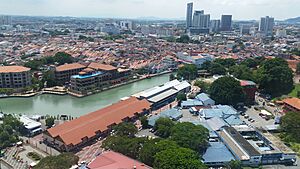
Malacca City has been a successful trading port for a long time. It was as important as Venice and Canton in the past. When Europeans arrived, Malacca became a city with many different cultures. Chinese traders and workers also helped the economy grow. This was especially true during Dutch and British rule.
Today, tourism is very important for Malacca's economy. Its rich history and mix of cultures attract many local and foreign visitors. The city's location on the maritime Silk Road also helps its economy. Malacca City hosts many conferences and trade fairs. A new economic area called the Hang Tuah Trade Centre is being developed. It will include trade centers, universities, hotels, and businesses.
Getting Around Malacca City
Land Travel
Roads in Malacca City are mostly federal roads. They are built and kept up by the Malaysian Public Works Department. You can reach the city using the North–South Expressway. The coastal Syed Abdullah Aziz Road is also a main route. There is an old main road system too. In the old city center, you can ride a trishaw. Some roads in the city are closed on Saturdays from 6 PM to midnight.
There was a plan to build a bridge called the Malacca Strait Bridge. It would connect Malacca City with Dumai in Sumatra, Indonesia.
Public Transport
Melaka Sentral is the main bus and taxi station in Malacca City. It offers services within the city and to other parts of Peninsular Malaysia. Some taxis also go to Singapore.
Before World War II, there were railway tracks from Pulau Sebang to Malacca City. But the Japanese removed them to build the Burma–Siam Railway. In 2015, a new shuttle train service started. It runs between Seremban, Sebang/Tampin, and Gemas stations.
The Malacca Monorail opened in 2010. It runs along the Malacca River. It stopped working in 2013 due to technical issues. But in 2015, the state government decided to fix it. The monorail reopened in December 2017 with better safety features. It operates from 10 AM to 10 PM on weekdays. On Saturdays and Sundays, it runs until midnight.
Water Travel
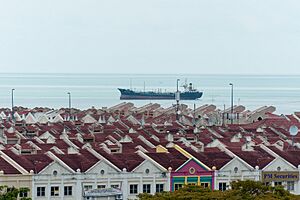
The main water transport in the city is the Malacca River Cruise. You can take evening cruises along the Malacca River. The cruise route marks the border between historic Chinatown and the Malay area.
The Melaka Gateway is a project being built. It involves creating new islands off the coast. This project will include an international cruise terminal. An international shipping port is also planned as part of China's Maritime Silk Route.
Other Important Services
Healthcare in Malacca
Malacca City has one public hospital and twelve government health clinics. There are also 52 private clinics and three 1Malaysia clinics. Malacca General Hospital is the main public hospital. It has 359 beds. Oriental Melaka Straits Medical Centre is the largest private hospital with 300 beds. Mahkota Medical Centre is the second largest with 266 beds.
Education in Malacca
Malacca City has many government and state schools. Secondary schools include Malacca High School, Malacca Girls High School, and Catholic High School. There are also religious, vocational, and technical schools. Some independent private schools are also in the city. These include Melaka International School and Wesley Methodist School.
Libraries for Learning
Malacca State Library is the main library for the state. It is located in Bukit Baru town. Other public library branches are in Telok Mas, Kampung Padang, Bertam Hulu, and Klebang. Libraries are also available in the city's universities, schools, and colleges.
Malacca's Culture and Fun Things to Do
Arts and Heritage
The Malacca Sultanate Palace Museum is a replica of an old palace. It shows Malay culture and Malacca's history during the sultanate era. The building was built without using any nails.
The city has many other cultural places to visit. These include Chinatown, Little India, and the Portuguese Settlement. Chinatown shows strong Chinese culture. It has clan associations, Chinese restaurants, and temples like Cheng Hoon Teng. Jonker Walk is a famous part of Chinatown where outdoor shows happen.
Restaurants in the city serve a mix of Malay, Baba Nyonya, and Chinese foods. The No 8 Heeren Street Heritage Centre is an old shop house being restored. The Cheng Ho Cultural Museum is where the famous Chinese voyager Zheng He is believed to have set up a large warehouse. The Straits Chinese Jewellery Museum has a collection of Chinese jewelry designs.
Little India is where you can experience Indian culture. It has many Indian shops and restaurants. The Portuguese Settlement is like a "Mini Lisbon." It is a center for Portuguese culture. Many Eurasians, who are descendants of Portuguese and Malay marriages, live there. The Encore Melaka theatre also hosts cultural and musical shows.
Historical Sites to Explore
The Dutch Square is surrounded by old Dutch buildings. These include the Stadthuys and Christ Church. You can also see the British Queen Victoria Fountain and the Chinese Tan Beng Swee Clock Tower. The Portuguese influence can be seen at Porta do Santiago and St. Peter's Church. The Kuomintang Cenotaph in Bukit Cina remembers the Chinese people killed by the Japanese during their occupation.
Fun and Nature Areas
Malacca Zoo is the main zoo in the city. It has 215 different types of animals. These include the Sumatran rhinoceros and the Indochinese tiger. An oceanarium inside The Shore shopping mall has many fish and sea creatures.
Other Cool Attractions
Other attractions include the Maritime Museum and Taming Sari Tower. The Maritime Museum has a replica of an old ship, the Flor de la Mar. It tells the story of Malacca's trading past. The Taming Sari Tower offers great views of the city. The Padang Pahlawan is where Tunku Abdul Rahman, Malaysia's first Prime Minister, first announced independence. St. Paul's Hill has the Governor's Museum and the Malacca Literature Museum.
Shopping Fun
You can find many shopping malls and traditional craft shops in the city. Popular malls include Dataran Pahlawan Melaka Megamall, The Shore, and the ÆON Bandaraya Melaka.
Entertainment Spots
The main cinemas in Malacca City are Golden Screen Cinemas (GSC). One is in Dataran Pahlawan Malacca Megamall. Another is in ÆON Bandaraya Melaka. There is also an MBO Cinemas in MBO Melaka Mall.
Sports in Malacca
The Hang Tuah Stadium is the second largest football stadium in Malacca. It is in the city and can hold about 15,000 people. It is the oldest stadium in the state. The stadium is one of the home grounds for the Melaka United football team.
Malacca's Friends Around the World
Malacca started making friends with other cities in 1984. Its first twin city was Lisbon, Portugal. Here are some of the cities that Malacca is now friends with:
 Valparaíso, Chile.
Valparaíso, Chile. Changsha, China.
Changsha, China. Guangdong, China.
Guangdong, China. Nanjing, China.
Nanjing, China. Kota Tua Jakarta, Indonesia.
Kota Tua Jakarta, Indonesia. Padang Panjang, Indonesia.
Padang Panjang, Indonesia. Sawahlunto, Indonesia.
Sawahlunto, Indonesia. Kuala Lumpur, Malaysia.
Kuala Lumpur, Malaysia. Hoorn, Netherlands.
Hoorn, Netherlands. Lisbon, Portugal.
Lisbon, Portugal.
See also
 In Spanish: Malaca (ciudad) para niños
In Spanish: Malaca (ciudad) para niños


